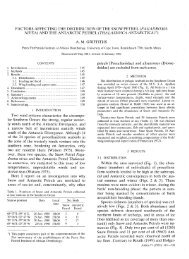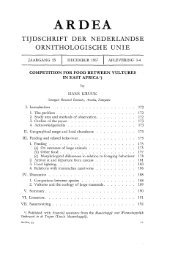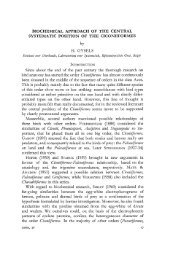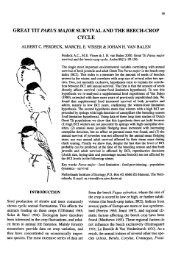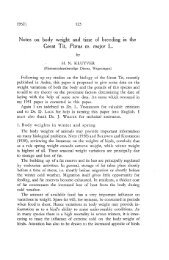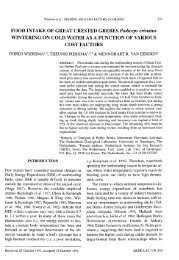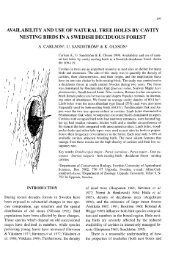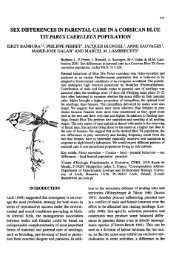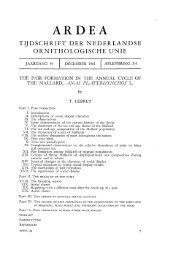utilization of mangroves by birds in guinea-bissau - ardeajournal ...
utilization of mangroves by birds in guinea-bissau - ardeajournal ...
utilization of mangroves by birds in guinea-bissau - ardeajournal ...
You also want an ePaper? Increase the reach of your titles
YUMPU automatically turns print PDFs into web optimized ePapers that Google loves.
± mean high water<br />
Rhizophora racemosa<br />
& R. harrisonii<br />
UTILIZATION OF MANGROVES BY BIRDS<br />
tanne<br />
- I j<br />
lpossible area for reclamation <strong>in</strong>to ricefields<br />
Elaeis Adansonia<br />
estuar<strong>in</strong>e terrace<br />
Fig.2. Outl<strong>in</strong>e zonation <strong>of</strong> mangrove vegetation <strong>in</strong> Gu<strong>in</strong>ea-Bissau (after Blasco 1983 and SECA/CML 1987).<br />
grove swamp, usually with<strong>in</strong> Avicennia). Though<br />
SCET (1978) mentioned a yearly decrease <strong>of</strong> c.<br />
20 km 2 , the mangrove area decreased <strong>by</strong> only<br />
0.7% dur<strong>in</strong>g 1976-85 (Diemont & Pons 1986).<br />
The estimations <strong>of</strong> mCN (1983) and Altenburg<br />
(1987) <strong>of</strong> c. 2,400 km 2 are probably too low, but<br />
roughly comparable with the above-mentioned<br />
figure without tannes and areas with scattered<br />
<strong>mangroves</strong>. The proportion <strong>of</strong> the different mangrove<br />
species is unknown. Rhizophora, which<br />
usually forms a wide strip along the seaside,<br />
seems to be the most abundant species. The <strong>mangroves</strong><br />
studied (Fig. 1) consisted largely <strong>of</strong> Rhizophora,<br />
with a narrow - wide strip <strong>of</strong> Avicennia<br />
on the <strong>in</strong>land side. Around tannes and on the isolated<br />
island Areias Avicennia was the dom<strong>in</strong>at<strong>in</strong>g<br />
species.<br />
Observations<br />
To determ<strong>in</strong>e the composition <strong>of</strong> bird species,<br />
presence and numbers <strong>of</strong> all species were noted<br />
dur<strong>in</strong>g field work <strong>in</strong> or near the <strong>mangroves</strong>.<br />
Mangrove swamps were divided <strong>in</strong>to three easily<br />
recognizable types: a) on the <strong>in</strong>land side adjo<strong>in</strong><strong>in</strong>g<br />
rice fields, b) on the <strong>in</strong>land side adjo<strong>in</strong><strong>in</strong>g<br />
"forest" (consist<strong>in</strong>g <strong>in</strong> the archipelago mostly <strong>of</strong><br />
palm trees Elaeis gu<strong>in</strong>eensis, and on the ma<strong>in</strong>land<br />
<strong>of</strong> palm trees, secondary forest and woodland),<br />
c) isolated (the mangrove island Areias, c.<br />
7 km from the ma<strong>in</strong>land <strong>in</strong> the Canal do Geba).<br />
Subdivisions <strong>in</strong> Avicennia and Rhizophora<br />
were difficult to make due to a large overlap <strong>in</strong><br />
their <strong>utilization</strong> <strong>by</strong> <strong>birds</strong>; the text will give the<br />
most important examples where this overlap was<br />
small. The data do not <strong>in</strong>dicate important differences<br />
between <strong>mangroves</strong> on the ma<strong>in</strong>land and<br />
those <strong>in</strong> the archipelago; both areas will therefore<br />
be treated together.<br />
In the three mangrove types observations<br />
were done dur<strong>in</strong>g field work <strong>in</strong>volv<strong>in</strong>g c. 15 days<br />
each. The presence <strong>of</strong> the majority <strong>of</strong> the species<br />
could already be determ<strong>in</strong>ed with<strong>in</strong> 2-3 days; the<br />
observations will therefore give a good idea <strong>of</strong><br />
the species composition <strong>in</strong> the <strong>mangroves</strong> dur<strong>in</strong>g<br />
the study period, but will def<strong>in</strong>itely not be complete.<br />
To supplement the observations, <strong>birds</strong> were<br />
trapped with mistnets <strong>in</strong> the daytime dur<strong>in</strong>g c.<br />
30 hours per mangrove type (4-6 days with an<br />
average <strong>of</strong> 60-90 m mistnets). Trapp<strong>in</strong>g took<br />
place at random, <strong>in</strong> Avicennia, Rhizophora and<br />
above small creeks; the trapp<strong>in</strong>g height <strong>of</strong> the<br />
nets was c. 50-200 cm.<br />
To get an idea <strong>of</strong> the density <strong>in</strong> the <strong>mangroves</strong><br />
<strong>of</strong> the most important bird species, apart<br />
from roost<strong>in</strong>g <strong>birds</strong>, a small number <strong>of</strong> counts<br />
has been performed. The counts covered the<br />
<strong>mangroves</strong> from seaside to <strong>in</strong>land side and thus<br />
from Rhizophora to Avicennia. Because <strong>of</strong> the<br />
very poor accessibility <strong>of</strong> the Rhizophora part,<br />
59
62 ARDEA 77 (1989)<br />
and feed <strong>in</strong> the rice fields from sunset on. Some<br />
seed-eat<strong>in</strong>g doves, <strong>of</strong> which Streptopelia v<strong>in</strong>acea<br />
was the most common, frequently used the<br />
edges <strong>of</strong> these <strong>mangroves</strong> as a base for forag<strong>in</strong>g<br />
flights <strong>in</strong>to the rice fields. The k<strong>in</strong>gfisher Alcedo<br />
cristata was especially common <strong>in</strong> <strong>mangroves</strong><br />
adjo<strong>in</strong><strong>in</strong>g rice fields, where the species was <strong>of</strong>ten<br />
observed hunt<strong>in</strong>g.<br />
Numbers<br />
Apart from remarks on some species like<br />
"common", "locally", etc. <strong>in</strong> various "handbooks"<br />
(Macworth-Praed & Grant 1970 and 1973,<br />
Serle & Morel 1977, Brown et al. 1982, Urban et<br />
al. 1986, Fry et al. 1988), quantitative data on<br />
<strong>birds</strong> <strong>in</strong> African <strong>mangroves</strong> have not been published.<br />
The summary <strong>of</strong> our observations <strong>in</strong> Appendix<br />
I gives a rough idea <strong>of</strong> the relative abundance<br />
<strong>of</strong> the species, though the registration chance<br />
will have varied. Species which have not been<br />
recorded are probably uncommon or absent <strong>in</strong><br />
the <strong>mangroves</strong> <strong>of</strong> Gu<strong>in</strong>ea-Bissau, at least from<br />
December through February.<br />
Of the c. I million w<strong>in</strong>ter<strong>in</strong>g coastal waders<br />
<strong>in</strong> Gu<strong>in</strong>ea-Bissau (Zwarts 1988) several hundred<br />
thousands will have used mangrove trees as a<br />
high tide roost, while most <strong>of</strong> the rema<strong>in</strong><strong>in</strong>g <strong>birds</strong><br />
roosted on tannes with<strong>in</strong> the <strong>mangroves</strong>. The greater<br />
part <strong>of</strong> the large wad<strong>in</strong>g <strong>birds</strong> which feed on<br />
the mudflats had their high-tide roost <strong>in</strong> the <strong>mangroves</strong>.<br />
This applied to several thousands <strong>of</strong><br />
<strong>birds</strong>, while their night roosts <strong>in</strong> <strong>mangroves</strong> may<br />
have held tens <strong>of</strong> thousands. Most <strong>of</strong> the terns<br />
roosted on tannes and beaches and their roost<strong>in</strong>g<br />
<strong>in</strong> <strong>mangroves</strong> was limited to hundreds rather than<br />
thousands <strong>of</strong> <strong>birds</strong>. We estimate the number <strong>of</strong><br />
roost<strong>in</strong>g <strong>birds</strong> <strong>of</strong> prey at several thousands for<br />
Gypohierax angolensis and several hundreds for<br />
Pandion haliaetus and Haliaetus vocifer.<br />
Both the mistnet catches (Table 2) and the<br />
sample counts (Table 3) agree with these observations.<br />
The species which have not been caught<br />
frequently, usually fly higher than the nets (c.<br />
parvus, H. lucida, L. harbarus, M. persicus) or<br />
occur mostly <strong>in</strong> open Avicennia (A. hypoleucos,<br />
N. phaeopus, N. pulchella) or along the open se-<br />
award edge (c. rudis) where catch<strong>in</strong>g is more<br />
difficult. As with sight observations, chances <strong>of</strong><br />
catch<strong>in</strong>g the species will have varied.<br />
The counts made <strong>in</strong> six small mangrove plots<br />
(Table 3), though the latter are a negligible proportion<br />
<strong>of</strong> the total mangrove area <strong>of</strong> c. 3,000<br />
km 2 , may give an idea <strong>of</strong> the order <strong>of</strong> magnitude<br />
<strong>of</strong> bird densities. The figures <strong>in</strong> Table 3 are m<strong>in</strong>ima.<br />
Both <strong>in</strong> Tables 2 and 3 the observed densities<br />
vary considerably from place to place; the reason<br />
for this is not known, but is probably related to<br />
factors like food resources, shelter and predators.<br />
When densities as <strong>in</strong> Table 3 get near the<br />
average for the whole mangrove area <strong>of</strong> Gu<strong>in</strong>ea<br />
Bissau, for the period December through February<br />
bird numbers <strong>of</strong> the species <strong>in</strong> the lower half<br />
<strong>of</strong> the table may amount at least to thousands,<br />
and <strong>in</strong> the upper half at least to tens <strong>of</strong> thousands.<br />
Aga<strong>in</strong> with densities as <strong>in</strong> Table 3, numbers <strong>of</strong><br />
the palearctic migrants Acrocephalus scirpaceus,<br />
Hippolais polyglotta and Phylloscopus trochilus<br />
may exceed half a million <strong>birds</strong>.<br />
DISCUSSION<br />
Species composition<br />
Mangrove swamps are relatively extreme habitats:<br />
they are regularly flooded <strong>by</strong> salt water<br />
and their variation <strong>in</strong> food items is small. Neither<br />
Avicennia nor Rhizophora bears a fruit that is<br />
edible <strong>by</strong> <strong>birds</strong>; food resources between and above<br />
the mangrove trees are therefore limited to <strong>in</strong>sects<br />
(Cawkell 1964). On and <strong>in</strong> the ground food<br />
is largely restricted to crabs (especially Uca tangeri)<br />
and mudskippers (Periophtalmus papilio);<br />
macrobenthos is probably neither rich nor varied<br />
<strong>in</strong> the strongly deoxygenated soil (Macnae &<br />
Kalk 1962, Macnae 1968). In creeks, gullies and<br />
puddles which rema<strong>in</strong> after-high water, food consists<br />
largely <strong>of</strong> fish, shrimps and water <strong>in</strong>sects.<br />
Descriptions <strong>of</strong> bird communities found <strong>in</strong><br />
<strong>mangroves</strong> <strong>in</strong> the different parts <strong>of</strong> the world<br />
mentioned <strong>in</strong> the <strong>in</strong>troduction all show that <strong>mangroves</strong><br />
are particularly used (apart from roost<strong>in</strong>g<br />
<strong>birds</strong>) <strong>by</strong> <strong>in</strong>sect-eat<strong>in</strong>g species (especially war-
UTILIZATION OF MANGROVES BY BIRDS 63<br />
Table 2. Mistnet catches <strong>in</strong> <strong>mangroves</strong> <strong>in</strong> Gu<strong>in</strong>ea-Bissau, Dec 1986 - Febr 1987. Catch<strong>in</strong>g sites d. Fig. 1. The<br />
figures represent the number <strong>of</strong> <strong>birds</strong> caught/IO hours/IOO m mistnets. Trapp<strong>in</strong>g took place at random (trapp<strong>in</strong>g<br />
height <strong>of</strong> the nets c. 50-200 cm), <strong>in</strong> Avicennia, Rhizophora and above small creeks dur<strong>in</strong>g c. 30 hours (Ri 35<br />
hours on 6 days with an average <strong>of</strong> 59 m mistnets; Fo 29, 4, 75; Is 34, 6, 93). The first half <strong>of</strong> the table holds the<br />
18 "very frequently" observed species from Table I.<br />
Acrocephalus scirpaceus<br />
Anthreptes gabonicus<br />
Cypsiurus parvus<br />
Eremomela pusilla<br />
Hippolais polyglotta<br />
Hirundo Lucida<br />
Laniarius barbarus<br />
Merops persicus<br />
Nectar<strong>in</strong>ia pulchella<br />
Phylloscopus trochilus<br />
Platysteira cyanea<br />
Sylvia cantillans<br />
Alcedo cristata<br />
Ceryle rudis<br />
Halcyon malimbica<br />
Actitis hypoleucos<br />
Numenius phaeopus<br />
Ploceus cucullatus<br />
Phylloscopus collybita<br />
Caprimulgus climacurus<br />
Mesopicos goertae<br />
Acrocephalus schoenobaenus<br />
Alcedo quadribrachys<br />
Butorides striatus<br />
Merops albicollis<br />
Pogoniulus chrysoconus<br />
Sylvietta brachyura<br />
Cisticola hrachyptera<br />
Dryoscopus gamhensis<br />
Indicator maculatus<br />
Anthus trivialis<br />
Centropus senegalensis<br />
Cossypha niveicapilla<br />
Ispid<strong>in</strong>a picta<br />
lynx torquilla<br />
Lanius senator<br />
Motacilla flava<br />
Ploceus nigricollis<br />
Sylvia atricapilla<br />
Tr<strong>in</strong>ga totanus<br />
Zosterops senegalensis<br />
Ri<br />
8.3<br />
6.4<br />
4.9<br />
1.5<br />
1.0<br />
1.0<br />
1.0<br />
3.4<br />
2.0<br />
2.4<br />
1.0<br />
16.1<br />
0.5<br />
0.5<br />
1.0<br />
1.0<br />
2.0<br />
0.5<br />
2.4<br />
0.5<br />
1.0<br />
Fo<br />
1.4<br />
4.1<br />
3.2<br />
0.5<br />
0.9<br />
2.8<br />
4.6<br />
0.9<br />
0.5<br />
8.3<br />
0.9<br />
0.5<br />
0.5<br />
0.9<br />
0.5<br />
Is<br />
9.8<br />
3.2<br />
3.8<br />
0.6<br />
8.9<br />
1.6<br />
3.2<br />
1.6<br />
0.6<br />
0.3<br />
0.3<br />
1.0<br />
0.3<br />
0.3<br />
0.3<br />
0.3<br />
7.0<br />
1.9<br />
0.3<br />
1.0<br />
0.3
64 ARDEA 77 (1989)<br />
Table 3. Mangrove counts <strong>in</strong> Gu<strong>in</strong>ea-Bissau, Jan - Febr 1987. The figures represent densities/1O ha. The first<br />
half <strong>of</strong> the table holds the 18 "very frequently" observed species from Table 1. Places 1-6 cf. Fig. 1. @ Only s<strong>in</strong>g<strong>in</strong>g<br />
males, * palearctic migrant, Ri Rice field, Fo Forest, Is Isolated (Areias). 1,6 Fairly open, 1.5-3 m high<br />
Avicennia; 2,3 Dense, 5 m high Rhizophora, pass<strong>in</strong>g <strong>in</strong>to open, 1-3 m high Avicennia; 4 Dense, 3-8 m high<br />
Rhizophora; 5 Fairly open, 5 m high mix <strong>of</strong> Avicennia/Rhizophora, pass<strong>in</strong>g <strong>in</strong>to fairly open, 1.5-3 m high<br />
Avicennia.<br />
Place 1 2 3 4 5 6<br />
Date 04-2 19-1 22-1 26-1 11-1 01-2<br />
Area (ha) 5.4 6.0 4.0 4.0 4.5 4.5<br />
Adjo<strong>in</strong><strong>in</strong>g Ri Fo Fo Fo Is Is<br />
Acrocephalus scirpaceus* 35 10 23 18 96 162<br />
Anthreptes gabonicus 4 10 30 113 2<br />
Cypsiurus parvus 48<br />
Eremomela pusilla 28 28 8<br />
Hippolais polyglotta* 6 8 5 10 178 51<br />
Hirundo lucida 3 5 9<br />
Laniarius barbarus 6 12 5<br />
Merops persicus 19 7 13 7<br />
Nectar<strong>in</strong>ia pulchella 17 18<br />
Phylloscopus sp.* 4 10 8 28 76 33<br />
Platysteira cyanea@ 2 8 25 131 9<br />
Sylvia sp.* 13 4 3 4 36 2<br />
Alcedo cristata 2 5<br />
Ceryle rudis 6 3 8 5<br />
Halcyon malimbica 11 7 5 5 4<br />
Actitis hypoleucos* 4 5 8 3 2 7<br />
Numenius phaeopus* 9 5 20 3 2<br />
Ploceus cucullatus 52 350 63 50 7<br />
Gypohierax angolensis 10 3 18 4<br />
Motacilla flava* 6 44 9<br />
Centropus senegalensis 4 4 2<br />
Tr<strong>in</strong>ga totanus* 3 7 4<br />
Ploceus nigricollis 5 9 9<br />
Turtur afer 5 5 8<br />
Burh<strong>in</strong>us senegalensis 2 3<br />
Streptopelia semitorquata 3 3<br />
Butorides striatus 6<br />
Coracias a<strong>by</strong>ss<strong>in</strong>ica 4<br />
Nectar<strong>in</strong>ia verticalis 4<br />
Merops pusillus 2<br />
Phalacrocorax africanus 2<br />
Phoeniculus purpureus 8<br />
Pycnonotus barbatus 5<br />
Mesopicos goertae 2<br />
Egretta gularis 10<br />
Tr<strong>in</strong>ga nebularia* 3<br />
Psittacus erithacus 3<br />
Tersiphone rufiventer 3<br />
Tockus nasutus 5<br />
Anthus trivialis* 2
iers Sylviidae, t1ycatchers Muscicapidae, shrikes<br />
Laniidae and sun<strong>birds</strong> Nectar<strong>in</strong>iidae), fish<br />
(and <strong>in</strong>sect-) eat<strong>in</strong>g species (especially herons<br />
and egrets Ardeidae and k<strong>in</strong>gfishers Alcedidae)<br />
and crab-eat<strong>in</strong>g species (some <strong>of</strong> the waders<br />
Charadriidae). The only two species <strong>in</strong> Africa<br />
which are largely conf<strong>in</strong>ed to mangrove swamps<br />
represent these groups: the fish-, crab- and <strong>in</strong>sect-eat<strong>in</strong>g<br />
Mangrove K<strong>in</strong>gfisher Halcyon senegaloides<br />
<strong>in</strong> East Africa (McNae 1968, Williams<br />
& Arlot 1980) and the <strong>in</strong>sect-eat<strong>in</strong>g Brown Sunbird<br />
Anthreptes gabonicus <strong>in</strong> West Africa (e.g.<br />
Chap<strong>in</strong> 1954).<br />
The species composition <strong>in</strong> Gu<strong>in</strong>ea-Bissau<br />
corresponds completely with this: <strong>in</strong>sectivorous<br />
and piscivorous species dom<strong>in</strong>ate Appendix 1<br />
(all species) and Table 1 (the most numerous species<br />
apart from roost<strong>in</strong>g <strong>birds</strong>). Seed- and fruiteat<strong>in</strong>g<br />
species were usually scarce, <strong>of</strong>ten occurr<strong>in</strong>g<br />
<strong>in</strong> a small strip on the <strong>in</strong>land side only.<br />
These were ma<strong>in</strong>ly species found <strong>in</strong> adjo<strong>in</strong><strong>in</strong>g<br />
rice fields and forests (doves Columbidae and<br />
weavers Ploceidae + Estrildidae). In the isolated<br />
<strong>mangroves</strong> <strong>of</strong> Areias these species were rare or<br />
absent. The only common seed-eater <strong>in</strong> the <strong>mangroves</strong><br />
was Ploceus cucullatus, which used mangrove<br />
trees as a base for forag<strong>in</strong>g flights to adjo<strong>in</strong><strong>in</strong>g<br />
rice fields. This species was also abundant<br />
<strong>in</strong> the middle <strong>of</strong> extensive mangrove swamps,<br />
though less so on the isolated Areias. Possibly its<br />
diet is augmented here with <strong>in</strong>sects or even t10wer<br />
juices (cf. Macworth-Praed & Grant 1970<br />
73). The weaver Ploceus nigricollis is largely <strong>in</strong>sectivorous<br />
(Cawkell 1964). The less frequently<br />
observed <strong>birds</strong> <strong>of</strong> prey were mostly seen hunt<strong>in</strong>g<br />
above the <strong>mangroves</strong>, usually t1y<strong>in</strong>g to or from<br />
adjo<strong>in</strong><strong>in</strong>g areas. Pandion haliaetus and Haliaetus<br />
vocij"er used high Rhizophora tree tops on the<br />
water's edge as "look-out" and roost. Many<br />
Gypohierax angolensis used Rhizophora as a<br />
high tide roost; some <strong>of</strong> these <strong>birds</strong> fed on Uca<br />
and carrion on the mudt1ats, <strong>in</strong> open Avicennia<br />
and on tannes.<br />
Table 4 confirms the similarity <strong>in</strong> species<br />
composition <strong>of</strong> different African mangrove areas<br />
(Gu<strong>in</strong>ea-Bissau, Sierra Leone, Gambia), though<br />
UTILIZATION OF MANGROVES BY BIRDS 65<br />
numbers <strong>of</strong> observed species vary considerably.<br />
This may be due to differences <strong>in</strong> observation<br />
time rather than to real differences <strong>in</strong> species<br />
numbers. Certa<strong>in</strong>ly the list for Sierra Leone is<br />
not complete (Field 1968). Observations <strong>in</strong> <strong>mangroves</strong><br />
<strong>of</strong> Gu<strong>in</strong>ea (Altenburg & van der Kamp<br />
1989), situated between Gu<strong>in</strong>ea-Bissau and Sierra<br />
Leone, are comparable with those <strong>in</strong> Table 4.<br />
Importance for <strong>birds</strong><br />
In this part <strong>of</strong> West Africa mangrove swamps<br />
cover at least 11,000 km 2 from Senegal to Sierra<br />
Leone (IUCN 1983). Apart from ensur<strong>in</strong>g coastal<br />
stability and accelerat<strong>in</strong>g shore development<br />
(Malt<strong>by</strong> 1986), which <strong>in</strong> a way affect the position<br />
and size <strong>of</strong> mudt1ats and coastal marshes, an important<br />
function <strong>of</strong> <strong>mangroves</strong> is their support <strong>of</strong><br />
the mar<strong>in</strong>e food web <strong>by</strong> the organic debris produced<br />
<strong>by</strong> the vegetation (e.g. Lugo & Snedaker<br />
1974). Mangrove swamps enhance the productivity<br />
<strong>of</strong> mudt1ats and shallow coastal waters, promot<strong>in</strong>g<br />
nursery conditions for <strong>in</strong>vertebrates,<br />
crabs and fish, and are thus essential, though<br />
<strong>in</strong>directly, for <strong>birds</strong> depend<strong>in</strong>g on these food<br />
sources (macrobenthos: waders; crabs: waders, at<br />
least partly Threskiornis aethiopica and Gelochelidon<br />
nilotica; fish: wad<strong>in</strong>g <strong>birds</strong>, terns, k<strong>in</strong>gfishers,<br />
Pandion haliaetus, Haliaetus vocifer).<br />
Many species <strong>of</strong> these groups occur <strong>in</strong> large<br />
numbers on the mudt1ats and <strong>in</strong> the <strong>mangroves</strong> <strong>of</strong><br />
Gu<strong>in</strong>ea-Bissau <strong>in</strong> w<strong>in</strong>ter. For most <strong>of</strong> these, especially<br />
the afro-tropical species, the relative importance<br />
<strong>of</strong> their numbers is unknown because<br />
data on breed<strong>in</strong>g populations, migration or w<strong>in</strong>ter<strong>in</strong>g<br />
grounds are lack<strong>in</strong>g. Clear examples <strong>of</strong><br />
(groups <strong>of</strong>) palearctic species on which much<br />
more <strong>in</strong>formation is available are:<br />
Waders: Only recently has the <strong>in</strong>ternational<br />
importance <strong>of</strong> the mudt1at area from Gu<strong>in</strong>ea<br />
Bissau to Sierra Leone for waders become clear<br />
(Gu<strong>in</strong>ea-Bissau, Zwarts 1988; Gu<strong>in</strong>ea, Altenburg<br />
& van der Kamp 1988; Sierra Leone, Tye & Tye<br />
1987), <strong>by</strong> far the largest numbers w<strong>in</strong>ter<strong>in</strong>g <strong>in</strong><br />
Gu<strong>in</strong>ea-Bissau.<br />
Osprey: In Gu<strong>in</strong>ea-Bissau alone w<strong>in</strong>ter<strong>in</strong>g<br />
numbers <strong>of</strong> Pandion haliaetus amount to several
66 ARDEA 77 (1989)<br />
Table 4. Bird faunas <strong>of</strong> the <strong>mangroves</strong> <strong>of</strong> Gu<strong>in</strong>ea-Bissau (GB), Sierra Leone (SL, after Field 1968) and Gambia<br />
(GA, after CawkeIl1964). The families are arranged <strong>in</strong> the follow<strong>in</strong>g groups:<br />
Group A. Ma<strong>in</strong>ly <strong>in</strong>sect-eat<strong>in</strong>g passer<strong>in</strong>es and non-passer<strong>in</strong>es<br />
Group B. Ma<strong>in</strong>ly fish- and/or <strong>in</strong>sect-eat<strong>in</strong>g wad<strong>in</strong>g <strong>birds</strong>, terns and k<strong>in</strong>gfishers<br />
Group C. Ma<strong>in</strong>ly crab- and macrobenthos-eat<strong>in</strong>g waders<br />
Group D. Ma<strong>in</strong>ly seed- and fruit-eat<strong>in</strong>g passer<strong>in</strong>es and non-passer<strong>in</strong>es<br />
Group E. Birds <strong>of</strong> prey<br />
number <strong>of</strong> species number <strong>of</strong> species<br />
GB SL GA GB SL GA<br />
Group A Group C<br />
Apodidae 2 Burh<strong>in</strong>idae 1 1<br />
Caprimulgidae 1 Charadriidae 17 5<br />
Coraciidae 3 1<br />
Cuculidae 1 1 total 18 6<br />
Hirund<strong>in</strong>idae 5 2<br />
Indicatoridae 1<br />
Laniidae 3 3 4 Group D<br />
Meropidae 5 2 Bucerotidae 1 3<br />
Motacillidae 2 2 1 Capitonidae 1 1<br />
Muscicapidae 3 2 2 Columbidae 3 2 2<br />
Nectar<strong>in</strong>iidae 3 4 3 Corvidae 1 1<br />
Oriolidae 1 Estrildidae 3 4 2<br />
Picidae 3 2 Musophagidae 1<br />
Sylviidae 11 9 4 Phasianidae 1<br />
Timaliidae 1 1 Ploceidae 4 2 3<br />
Turdidae 1 2 Psittacidae 1 1<br />
Upupidae 2 Pycnonotidae 1 2<br />
Zosteropidae 1 Stumidae 1 1<br />
total 48 31 15 total 16 18 10<br />
Group B Group E<br />
Alcedidae 5 6 3 Aquilidae 7 5 2<br />
Anh<strong>in</strong>gida¢ 1 1 1 Pandionidae I 1 1<br />
Ardeidae 9 8 12 Strigidae 1<br />
Ciconiidae 1 1<br />
Gruidae 1 total 9 6 3<br />
Laridae 8<br />
Pelecanidae 1 sum totals 125 80 45<br />
Phalacrocciracidae 2<br />
Rallidae 1<br />
Scopidae 1<br />
Threskiornithidae 4<br />
total 34 19 17
nantly w<strong>in</strong>ters south <strong>of</strong> the Sahel (Wammes et<br />
ai. 1983) <strong>in</strong> forest and woodland savanna (Serle<br />
& Morel 1977). Dowsett et ai. (J 988) suggest that<br />
displacement <strong>of</strong> this species is to w<strong>in</strong>ter regions<br />
roughly south <strong>of</strong> the breed<strong>in</strong>g areas; their (limited!)<br />
r<strong>in</strong>g<strong>in</strong>g data <strong>in</strong>dicate <strong>in</strong> this part <strong>of</strong> coastal<br />
West Africa a w<strong>in</strong>ter<strong>in</strong>g population orig<strong>in</strong>at<strong>in</strong>g<br />
from the British Isles. Accord<strong>in</strong>g to Sharrock<br />
(J 976) British and Irish populations may exceed<br />
3 million pairs. Mangrove forests <strong>in</strong> Gu<strong>in</strong>ea<br />
Bissau and adjacent countries thus seem to form<br />
an important part <strong>of</strong> the w<strong>in</strong>ter<strong>in</strong>g grounds <strong>of</strong><br />
these populations.<br />
In contrast with Phylloscopus trochilus both<br />
Acrocephaius scirpaceus and Hippolais polyglotta<br />
are said to w<strong>in</strong>ter <strong>in</strong> Sahelian Africa north<br />
<strong>of</strong> the forest belt (e.g. Serle & Morel 1977,<br />
Wammes et al. 1983). However, for both species<br />
West African <strong>mangroves</strong> could well be a much<br />
more important w<strong>in</strong>ter<strong>in</strong>g area than the savanna<br />
zone. This is especially true for Hippolais polyglotta<br />
when consider<strong>in</strong>g the fact that the species<br />
is only "assez nombreux" (::; 100,000 pairs) <strong>in</strong><br />
France, its ma<strong>in</strong> breed<strong>in</strong>g area (Yeatman 1976).<br />
Also for Acrocephalus scirpaceus <strong>mangroves</strong><br />
probably constitute a major w<strong>in</strong>ter<strong>in</strong>g habitat,<br />
although the w<strong>in</strong>ter population, which <strong>in</strong> this part<br />
<strong>of</strong> coastal West Africa orig<strong>in</strong>ates from a large<br />
part <strong>of</strong> Western Europe (Z<strong>in</strong>k 1973, Dowsett et<br />
al. 1988), is larger than that <strong>of</strong> the preced<strong>in</strong>g species<br />
(e.g. The Netherlands, Great Brita<strong>in</strong> and<br />
Ireland together 11 0,000-190,000 pairs, Sharrock<br />
1976, SOVON 1988). W<strong>in</strong>ter<strong>in</strong>g <strong>in</strong> <strong>mangroves</strong>,<br />
which are much less affected <strong>by</strong> drought than<br />
other Sahelian habitats, could well account for<br />
the fact that both species show no decl<strong>in</strong>e <strong>in</strong><br />
West European breed<strong>in</strong>g areas.<br />
ACKNOWLEDGEMENTS<br />
The work <strong>in</strong> and around the <strong>mangroves</strong> was part <strong>of</strong> a<br />
Dutch expedition to the coastal wetlands <strong>of</strong> Gu<strong>in</strong>ea<br />
Bissau under the auspices <strong>of</strong> the WIWO Foundation.<br />
The expedition was funded <strong>by</strong> the Beijer<strong>in</strong>ck-Popp<strong>in</strong>g<br />
Fonds, FONA, ICBP, IWRB, M<strong>in</strong>isterie van Landbouw<br />
en Visserij, Natuurmonumenten, Nederlands<br />
Comite Bescherm<strong>in</strong>g Trekvogels, Pr<strong>in</strong>s Bernhard<br />
UTILIZATION OF MANGROVES BY BIRDS 69<br />
Fonds, RSPB, Van Tienhoven Sticht<strong>in</strong>g, Tour du Valat<br />
and WWF-NL. The cooperation with the M<strong>in</strong>isterio do<br />
Desenvolvimento Rural and its <strong>of</strong>ficers Cipriano<br />
Cassama and Fai Djedjo was highly appreciated. We<br />
thank the members <strong>of</strong> the expedition - Jan van de<br />
Kam, Jan van der Kamp, Marcel Kersten, Bernard<br />
Spaans, Eddy Wymenga and Leo Zwarts for their help<br />
<strong>in</strong> collect<strong>in</strong>g the data and for their company, the crew<br />
<strong>of</strong> the M.S. Knud W (Jan van der Kamp and Bernard<br />
Spaans), Wiebren Plant<strong>in</strong>g and Benny Klazenga who<br />
prepared the figures, Jan van der Kamp and Beatrice<br />
Merlet who translated the French summary and Rob<br />
Bijlsma, Jo Ann van Seventer, Eddy Wymenga and<br />
Leo Zwarts who commented on the manuscript.<br />
REFERENCES<br />
Altenburg, W. 1987. Waterfowl <strong>in</strong> West African coastal<br />
wetlands: a summary <strong>of</strong> current knowledge.<br />
WIWO-report 15, Zeist.<br />
Altenburg, W. & J. van der Kamp 1986. Oiseaux d'eau<br />
dans les zones humides de la Mauritanie du Sud,<br />
du Senegal et de la Gu<strong>in</strong>ee-Bissau, octobre-decembre<br />
1983. RIN-Contr. 1986-1, Leersum.<br />
Altenburg, W. & J. van der Kamp 1988. Coastal waders<br />
<strong>in</strong> Gu<strong>in</strong>ea. Wader Study Group Bullet<strong>in</strong> 54:<br />
33-35.<br />
Altenburg, W. & J. van der Kamp 1989. Etude ornithologique<br />
prelim<strong>in</strong>aire de la zone c6tiere du nordouest<br />
de la Gu<strong>in</strong>ee. Jo<strong>in</strong>t report <strong>of</strong> WIWO and<br />
ICBP. WIWO-report 23, Zeist and ICBP study report<br />
30, Cambridge.<br />
Berthold, P. 1974. Die gegenwiirtige Bestartdsentwicklung<br />
der Dorngrasmlicke (Sylvia communis) und<br />
anderer S<strong>in</strong>gvogelarten im westlichem Europa bis<br />
1973. Vogelwelt 95: 170-183.<br />
Blasco, F. 1983. Mangroves du SCnI?gal et de Gambie.<br />
Institut de la Carte Internationale du Tapis Vegetal,<br />
Universite Toulouse.<br />
Brown, L. H., E. K. Urban & K. Newman 1982. The<br />
<strong>birds</strong> <strong>of</strong>Africa, Vol. I. Academic Press, London.<br />
Cawkell, E. M. 1964. The <strong>utilization</strong> <strong>of</strong> <strong>mangroves</strong> <strong>by</strong><br />
African <strong>birds</strong>. Ibis 106: 251-253.<br />
Chap<strong>in</strong>, J. P. 1954. The <strong>birds</strong> <strong>of</strong> the Belgian Congo,<br />
part 4. Bull. Amer. Mus. Nat. Hist. 75B.<br />
Cramp, S. (ed.) 1985. The <strong>birds</strong> <strong>of</strong> the Western<br />
Palearctic, Vol IV. Oxford University Press.<br />
Diemont, W. H. & L. J. Pons 1986. Conservation et<br />
gestion des <strong>mangroves</strong> de Gu<strong>in</strong>ee-Bissau. RINcontr.<br />
1986-4, Leersum.<br />
Diemont, W. H. & W. van Wijngaarden 1975. Nature<br />
conservation <strong>of</strong> <strong>mangroves</strong> <strong>in</strong> West-Malaysia.<br />
Report 293, LUW, Wagen<strong>in</strong>gen.
70 ARDEA 77 (1989)<br />
Dowsett, R. J., G. C. Backhurst & T. B. Oatley 1988.<br />
Afrotropica1 r<strong>in</strong>g<strong>in</strong>g recoveries <strong>of</strong> palearctic migrants<br />
1. Passer<strong>in</strong>es (Turdidae to Orio1idae).<br />
Tauraco 1: 29-63.<br />
Ffrench, R. P. 1966. The <strong>utilization</strong> <strong>of</strong> <strong>mangroves</strong> <strong>by</strong><br />
<strong>birds</strong> <strong>in</strong> Tr<strong>in</strong>idad. Ibis 108: 423-424.<br />
Field, G. D. 1968. Utilization <strong>of</strong> <strong>mangroves</strong> <strong>by</strong> <strong>birds</strong><br />
on the Freetown pen<strong>in</strong>sula, Sierra Leone. Ibis<br />
110: 354-357.<br />
Fry, C. H., S. Keith & E. K. Urban 1988. The <strong>birds</strong> <strong>of</strong><br />
Africa, Vol. III. Academic Press, London.<br />
Gerlach, S. A. 1958. Die Mangroveregion tropischer<br />
Klisten als Lebensraum. Z. Morph. u. Okol. Tiere<br />
46: 636-730.<br />
Gore, M. E. J. 1981. Birds <strong>of</strong> the Gambia. BOU,<br />
London.<br />
Haverschmidt, E 1965. The utilisation <strong>of</strong> <strong>mangroves</strong><br />
<strong>by</strong> South American <strong>birds</strong>. Ibis 107: 540-542.<br />
IUCN. 1983. Global status <strong>of</strong> mangrove ecosystems.<br />
Gland.<br />
Jacob, J. P., P. Devillers & J. P. Ledant 1984. Etude<br />
prelim<strong>in</strong>aire a une identification de la repartition<br />
ecologique et geographique en Afrique de certa<strong>in</strong>s<br />
elements de l'avifaune de la CEE. Rapport pour Ie<br />
CEE, Brussel.<br />
Lugo, A. E. & S. C. Snedaker 1974. The ecology <strong>of</strong><br />
<strong>mangroves</strong>. Ann. Rev. <strong>of</strong> Ecology and Systematics<br />
5: 39-55.<br />
Mackworth-Praed, C. W. & C. H. B. Grant 1970-73.<br />
Birds <strong>of</strong> west central and western Africa. 2 Vols.<br />
Longman, London and New York.<br />
Malt<strong>by</strong>, E. 1986. Waterlogged wealth. Earthscan,<br />
London and Wash<strong>in</strong>gton.<br />
Macnae, W. 1968. A general account <strong>of</strong> the flora and<br />
fauna <strong>of</strong> mangrove swamps and forests <strong>in</strong> the<br />
Indo-West-Pacific region. Adv. Mar. BioI. 6:<br />
73-270.<br />
Macnae, W. & M. Kalk 1962. The ecology <strong>of</strong> the mangrove<br />
swamps <strong>of</strong> Inhaca Island, MOl;ambique. J.<br />
Ecol. 50: 93-128.<br />
Melchior, E., E. Mentgen, R. Peltzer, R. Schmitt & J.<br />
Weiss (eds.) 1987. Atlas der Brutvogel Luxemburgs.<br />
Letzeblirger, Luxembourg.<br />
Naurois, R. de, 1969. Peuplements et cycles de reproduction<br />
des oiseaux de la cote occidentale d'Afrique,<br />
du Cap Barbas, Sahara Espagnol, a la frontiere<br />
de la Republique de Gu<strong>in</strong>ee. Mem. Mus.<br />
Hist. Nat. ser. A, Zoologie 56: 1-312.<br />
Nisbet, I. C. T. 1968. The <strong>utilization</strong> <strong>of</strong> <strong>mangroves</strong> <strong>by</strong><br />
Malayan <strong>birds</strong>. Ibis 110: 348-352.<br />
SCET. 1978. Potentialites agricoles, forestieres et pastorales.<br />
Rapport pour Ie gouvemement de Gu<strong>in</strong>ee<br />
Bissau. Wagen<strong>in</strong>gen.<br />
SECAjCML. 1987. Les <strong>mangroves</strong> du Senegal et de<br />
Gu<strong>in</strong>ee-Bissau. Centrum voor Milieukunde, RU<br />
Leiden.<br />
Serle, W. & G. J. Morel 1977. A field guide to the<br />
<strong>birds</strong> <strong>of</strong>West Africa. Coll<strong>in</strong>s, London.<br />
Sharrock, J. T. R. (ed.) 1976. The atlas <strong>of</strong> breed<strong>in</strong>g<br />
<strong>birds</strong> <strong>in</strong> Brita<strong>in</strong> and Ireland. BTO, Tr<strong>in</strong>g.<br />
Silvius, M. & W. Verheugt 1985. Mangroven. Natuur<br />
en Techniek 53: 576-587.<br />
Smit, C. J. & T. Piersma 1989. Numbers, mid-w<strong>in</strong>ter<br />
distribution and migrations <strong>of</strong> wader populations<br />
us<strong>in</strong>g the East Atlantic flyway. In: H. Boyd (ed.),<br />
Proceed<strong>in</strong>gs Conference conservation wetlands<br />
and waterfowl, Reg<strong>in</strong>a, Canada (<strong>in</strong> press).<br />
SOVON. 1988. Nieuwe aantalsschatt<strong>in</strong>gen van de<br />
Nederlandse broedvogels. Limosa 61: 151-162.<br />
Tye, A. & H. Tye 1987. The importance <strong>of</strong> Sierra<br />
Leone for w<strong>in</strong>ter<strong>in</strong>g waders. Wader Study Group<br />
Bullet<strong>in</strong> 49 Suppl/IWRB Special Publication 7:<br />
71-75.<br />
Urban, E. K., C. H. Fry & S. Keith 1986. The <strong>birds</strong> <strong>of</strong><br />
Africa, Vol. II. Academic Press, London.<br />
Wammes, D. E, G. C. Boere & S. Braaksma 1983. In<br />
hoeverre kunnen aantalsverander<strong>in</strong>gen van zangvogels<br />
<strong>in</strong> verband gebracht worden met hun trekgedrag?<br />
Limosa 56: 231-242.<br />
Williams, J. G. & N. Arlott 1980. A field guide to the<br />
<strong>birds</strong> <strong>of</strong>East Africa. Coll<strong>in</strong>s, London.<br />
W<strong>in</strong>stanley, D., R. Spencer & K. Williamson 1974.<br />
Where have all the Whitethroats gone? Bird<br />
Study 21: 1-14.<br />
Yeatman, L. 1976. Atlas des oiseaux nicheurs de<br />
France. Soc. am. France, Paris.<br />
Z<strong>in</strong>k, G. 1973. Der Zug Europaischer S<strong>in</strong>gvogel, 1.<br />
Vogelwarte Radolfzell, Konstanz.<br />
Zwarts, L. 1988. Numbers and distribution <strong>of</strong> coastal<br />
waders <strong>in</strong> Gu<strong>in</strong>ea-Bissau. Ardea 76: 42-55.<br />
SAMENVATTING<br />
Mangroven beslaan wereldwijd tenm<strong>in</strong>ste 14<br />
miljoen hectare. Helaas is over het belang ervan<br />
voor vogels nog maar we<strong>in</strong>ig bekend. Dat geldt<br />
zeker voor Afrikaanse mangrovegebieden. Tijdens<br />
een expeditie naar Gu<strong>in</strong>ee-Bissau aan de<br />
Afrikaanse westkust (december 1986 - februari<br />
1987) zijn een groot aantal vogelwaamem<strong>in</strong>gen<br />
<strong>in</strong> mangroven gedaan. Een aanzienlijk dee! van<br />
de <strong>in</strong> Appendix 1 genoemde 125 soorten betr<strong>of</strong><br />
m<strong>in</strong> <strong>of</strong> meer "toevallige" bezoekers, die maar een<br />
<strong>of</strong> enkele keren zijn waargenomen en vee! talrijker<br />
zijn <strong>in</strong> aangrenzende rijstvelden, savanne en<br />
bossen. Naast een aantal wad- en watervogels die<br />
de mangrove vooral gebruiken om er te overtijen,
is slechts een kle<strong>in</strong> aantal soorten heel frequent<br />
op (vrijwel) alle bezochte plaatsen aangetr<strong>of</strong>fen<br />
(Tabel 1, Fig. 3). Mistnetvangsten (Tabel 2) en<br />
gedetailleerde tell<strong>in</strong>gen (Tabel 3) bevestigen dit<br />
beeld.<br />
De soortensamenstell<strong>in</strong>g vertoont grote overeenkomsten<br />
met die <strong>in</strong> mangroven elders <strong>in</strong> de<br />
tropen, <strong>in</strong> het bijzonder <strong>in</strong> Gambia en Sierra<br />
Leone, beide ook aan de Afrikaanse westkust<br />
(Tabel 4). Dit is ongetwijfeld een direct gevolg<br />
van het voedselaanbod <strong>in</strong> het relatief extreme<br />
mangrove-habitat, dat goeddeels beperkt is tot<br />
<strong>in</strong>sekten, vis, modderkruipers (Periophtalmus<br />
papilio) en krabben (vooral de wenkkrab Uca<br />
tangeri). Insekteneters (met name zangers, klauwieren,<br />
vliegenvangers en hon<strong>in</strong>gzuigers), viseters<br />
(met name reigerachtigen en deels de ijsvogels)<br />
en krabeters (met name Oeverloper en<br />
Regenwulp) vormen het leeuwendeel van de<br />
waargenomen soorten, de overtijers uitgezonderd.<br />
Ook bij de meest talrijke soorten (Tabel 1)<br />
gaat het vrijwel uitsluitend om deze groepen.<br />
Op grond van de tell<strong>in</strong>gen zijn schatt<strong>in</strong>gen<br />
gemaakt van de dichtheden van de verschillende<br />
soorten (Tabel 3). Wanneer deze dichtheden representatief<br />
zijn voor het gehele mangrovegebied<br />
van Gu<strong>in</strong>ee-Bissau, gaat het om tenm<strong>in</strong>ste<br />
1O.OOO-en exemplaren bij de <strong>in</strong> Tabel 1 genoemde<br />
meest algemene soorten. Bij de palearctische<br />
zangers Fitis, Kle<strong>in</strong>e Karekiet en Orpheusspotvogel<br />
zou het dan om tenm<strong>in</strong>ste een half miljoen<br />
vogels gaan.<br />
Mangroven zijn van groot belang voor de<br />
productiviteit van wadden en ondiepe kustwateren<br />
en dus voor vogelsoorten die afhankelijk<br />
zijn van voedsel uit deze gebieden (vooral steltlopers,<br />
reigerachtigen, stems en Visarend). Deze<br />
groepen komen <strong>in</strong> grote aantallen voor <strong>in</strong> het<br />
kustgebied van Gu<strong>in</strong>ee-Bissau en waarschijnlijk<br />
langs een groot deel van de mangrovekust van<br />
Senegal - Sierra Leone. Voor steltlopers, Lachstem<br />
en Visarend betreft het hier <strong>in</strong>temationaal<br />
gezien belangrijke aantallen. Verder heeft het<br />
mangrovegebied een belangrijke functie als relatief<br />
veilige overtij<strong>in</strong>gsplaats voor lOO.OOO-en<br />
steltlopers en als resp. broed-, slaap- en overtij-<br />
UTILIZATION OF MANGROVES BY BIRDS 71<br />
<strong>in</strong>gsplaats voor belangrijke aantallen grote waadvogels<br />
(reigers, aalscholvers, lepelaars, ibissen).<br />
Veel van de genoemde soorten en groepen<br />
v<strong>in</strong>den buiten de mangroven hun voedsel. In de<br />
mangroven zelf komt maar een zeer beperkt aantal<br />
soorten <strong>in</strong> belangrijke aantallen voor. De afrotropische<br />
soorten uit Tabel 1 zijn voor zover bekend<br />
algemeen <strong>in</strong> grote delen van West-Afrika.<br />
Alleen de Bru<strong>in</strong>e Hon<strong>in</strong>gzuiger Anthreptes<br />
gabonicus is beperkt tot de mangrovezone van<br />
Gambia tot Zaire.<br />
Voor een aantal palearctische trekvogels zijn<br />
de Westafrikaanse mangroven waarschijnlijk van<br />
groot belang als overw<strong>in</strong>ter<strong>in</strong>gsgebied, met name<br />
voor Regenwulp, Kle<strong>in</strong>e Karekiet en Orpheusspotvogel.<br />
Eerstgenoemde soort overw<strong>in</strong>tert kennelijk<br />
<strong>in</strong> veel grotere aantallen <strong>in</strong> de mangroven<br />
dan op het wad. De beide zangvogels overw<strong>in</strong>teren<br />
<strong>in</strong> grote aantallen <strong>in</strong> de mangroven. Dit is<br />
misschien de belangrijkste reden dat ze niet, zoals<br />
zovele andere Sahel-overw<strong>in</strong>teraars onder de<br />
zangvogels, sterk zijn achteruitgegaan <strong>in</strong> de<br />
Westeuropese broedgebieden.<br />
RESUME<br />
In n'existe que peu de donnees sur l'importance omithologique<br />
de la foret de mangrove couvrant au mo<strong>in</strong>s<br />
14 million d'hectares mondialement. Cela vaut certa<strong>in</strong>ement<br />
pour les zones de <strong>mangroves</strong> en Afrique. Au<br />
cours d'une expedition en Gu<strong>in</strong>ee-Bissau (Fig. 1) situee<br />
ala cote ouest-africa<strong>in</strong>e (decembre 1986 - fevrier<br />
1987) un grand nombre d'observations ont ete faites<br />
dans la mangrove. Panni les 125 especes mentionnees<br />
dans I'Appendice 1 figure un nombre considerable de<br />
visiteurs plus ou mo<strong>in</strong>s accidentels; leur presence est<br />
beaucoup plus importante dans les rizieres, la savane<br />
et les forets attenantes. A part les oiseaux d'eau de la<br />
zone <strong>in</strong>tertidale qui utilisent la mangrove pr<strong>in</strong>cipalement<br />
pour y passer la periode des marees hautes, seul<br />
un petit nombre d'especes est signale tres ftequemment<br />
dans (presque) tous les endroits visites (Tableau 1, Fig.<br />
3). Les captures al'aide de filets (Tableau 2) a<strong>in</strong>si que<br />
des recensements detailles (Tableau 3) cortf<strong>in</strong>nent cette<br />
image.<br />
La composition des especes est a peu pres identique<br />
a celie des autres zones tropicales, particulierement<br />
en Gambie et en Sierra Leone situees egalement<br />
sur la cote ouest-africa<strong>in</strong>e (Tableau 4). Ceci est sans
72 ARDEA 77 (1989)<br />
doute la consequence directe de la disponibilite alimentaire<br />
propre al'habitat de mangrove assez extreme,<br />
se composant essentiellement d'<strong>in</strong>sectes, poissons, 10ches<br />
(Periophalmus papilio) et crabes (surtout Uca<br />
tangeri). Les oiseaux <strong>in</strong>sectivores (notamment les fauvettes,<br />
cisticoles etc. (Sylviidae), les pies-grieches, les<br />
gobe-mouches et les soui-mangas), piscivores (notamment<br />
les herons et aigrettes et partiellement les mart<strong>in</strong>s-pecheurs<br />
et mart<strong>in</strong>s-chasseurs) et crabivores (notamment<br />
Ie Chevalier guignette et Ie Courlis corlieu)<br />
constituent la grande majorite des especes observees,<br />
hors les especes '<strong>in</strong>tertidales'. Aussi chez les especes<br />
les plus nombreuses (Tableau 1) il s'agit presque exc1usivement<br />
de ces groupes.<br />
Tableau 3 donne une idee de l'ordre de densites des<br />
diverses especes. Si ces densites seraient approximatiyes<br />
a celles de la zone de mangrove entiere de la<br />
Gu<strong>in</strong>ee-Bissau, il s'agit de diza<strong>in</strong>es de milliers d'oiseaux<br />
au m<strong>in</strong>imum chez les especes les plus communes.<br />
Le Pouillot fitis, la Rousserole effarvate et la<br />
Hippolals polyglotte (passer<strong>in</strong>es palearctiques) representeraient<br />
alors un demi-million d'oiseaux au m<strong>in</strong>imum.<br />
La mangrove est d'une grande importance pour la<br />
productivite alimentaire des zones <strong>in</strong>tertidales et des<br />
mers peu pr<strong>of</strong>ondes; par consequence elle l'est aussi<br />
pour des especes d'oiseaux se nourrissant aux depends<br />
de ces aires (surtout limicoles, herons, aigrettes, sterries<br />
et Balbuzard pecheur). Ces groupes sont tres nombreux<br />
et, concernant les limicoles, la Sterne hansel et<br />
Ie Balbuzard pecheur, presents en effectifs importants<br />
au niveau mondial, dans la zone c6tiere dela Gu<strong>in</strong>ee<br />
Bissau et probablement dans une grande partie de celie<br />
attenante a la mangrove entre Ie senegal et la Sierra<br />
Leone. La fonction de reposoir amaree haute relativement<br />
sur pour des centa<strong>in</strong>es de milliers de limicoles<br />
est egalement importante. De meme les qualites de<br />
lieu de nidification, dortoir etreposoir a maree haute<br />
pour des nombres importants d'echassiers (herons, aigrettes,<br />
spatules, ibis) et de cormorants sont asouligner.<br />
Toutes ces fonctions concernent des especes qui<br />
s'alimentent generalement hors de la mangrove. Dans<br />
la mangrove elle-meme on ne trouve qu'un petit nombre<br />
d'especes en effectifS importants. Les especes afrotropicales<br />
du Tableau 1 sont, dans l'etat des connaissances<br />
actuelles, communes en grandes parties de<br />
I'Afrique occidentale. Seul Ie Soui-manga bron<br />
Anthreptes gabonicus se limite ala zone de mangrove<br />
entre la Gambie et Ie ZaIre. Pour un nombre de migrateurs<br />
palearctiques la mangrove ouest-africa<strong>in</strong>e parait<br />
etre d'un <strong>in</strong>teret enorme en tant que zone d'hivernage,<br />
notamment pour Ie Courlis corlieu, la Rousserole effarvate<br />
et la Hippolais polyglotte. La premiere de ces<br />
trois hiverne dans la zone de mangrove en nombres<br />
beaucoup plus grands que ceux presents dans la zone<br />
<strong>in</strong>tertidale. Les deux autres especes hivernent en nombres<br />
impressionants dans la mangrove; cela pourrait<br />
bien expliquer pourquoi leur effectifs, a l'oppose de<br />
beaucoup d'autres passer<strong>in</strong>es qui ont souffertdes periodes<br />
de secheresse dans les annees soixante-dix et<br />
quatre-v<strong>in</strong>gt, n'ont pas fortement dim<strong>in</strong>ue dans les aires<br />
de nidification ouest-europeennes.
UTILIZATION OF MANGROVES BY BIRDS 73<br />
Appendix 1. Presence <strong>of</strong> bird species <strong>in</strong> <strong>mangroves</strong> <strong>in</strong> Gu<strong>in</strong>ea-Bissau, December 1986 - February 1987.<br />
Mangroves are divided <strong>in</strong> those adjo<strong>in</strong><strong>in</strong>g rice fields (Ri), forested areas (Fo) and isolated <strong>mangroves</strong> (the island<br />
Areias, Is). The most important observation sites are shown <strong>in</strong> Fig. 1. With<strong>in</strong> the groups names and order <strong>of</strong> species<br />
follow Serle & Morel (1977) except for Merops persicus (Fry et al. 1988), Hirundo lucida/rustica<br />
(Mackworth-Praed & Grant 1970, 1973) and Circaetus gallicus (Brown et al. 1982).<br />
+ frequently observed, . once or occasionally observed, c caught with mistnets only, * palearctic migrant, (*) probably<br />
palearctic/afro-tropical mixture <strong>in</strong> unknown proportions. Information on food and orig<strong>in</strong> after Mackworth<br />
Praed & Grant (1970, 1973), Brown et al. (1982), Urban et al. (1986) and Fry et al. (1988).<br />
Ri: Rio Geba, Rio Mansoa; c. 50-1,000 m wide, <strong>by</strong> the seaside a wide strip <strong>of</strong> Rhizophora, <strong>by</strong> the landside a small<br />
strip <strong>of</strong> Avicennia. Fo: Bijagos, Rio Grande de Buba, Rio Tombali; c. 10-2,500 m wide, <strong>by</strong> the seaside a small <br />
wide strip <strong>of</strong> Rhizophora (Rio Tombali also Laguncularia), <strong>by</strong> the landside id. Avicennia. Is: Ilha das Areias; c.<br />
100-700 m wide, <strong>by</strong> the seaside a small strip <strong>of</strong> Rhizophora, <strong>by</strong> the "Iandside" a wide strip <strong>of</strong>Avicennia.<br />
A. Ma<strong>in</strong>ly <strong>in</strong>sect-eat<strong>in</strong>g<br />
(non-)passer<strong>in</strong>es<br />
Ri<br />
Centropus senegalensis +<br />
Caprimulgus climacurus<br />
Apus apus *<br />
Cypsiurus parvus + +<br />
Merops apiaster *<br />
Merops persicus + +<br />
Merops albicollis<br />
Merops pusillus<br />
Merops gularis<br />
Coracias a<strong>by</strong>ss<strong>in</strong>ica<br />
Coracias cyanogaster<br />
Eurystomus glaucurus<br />
Upupa epops (*)<br />
Phoeniculus purpureus<br />
Indicator maculatus<br />
lynx torquiquilla *<br />
Campethera maculosa<br />
Mesopicos goertae .<br />
Hirundo lucida + +<br />
Hirundo rustica * .<br />
Hirundo daurica (*)<br />
Hirundo spi/odera +<br />
Psalidoprocne obscura<br />
Motacillaflava *<br />
Anthus trivialis * +<br />
Dryoscopus gambensis<br />
Laniarius barbarus + +<br />
Lanius senator *<br />
Griolus nigripennis<br />
Cossypha niveicapilla<br />
Acrocephalus schoenobaenus *<br />
Fo<br />
+<br />
c<br />
c<br />
+<br />
+<br />
c<br />
Is<br />
+<br />
Ri<br />
Acrocephalus scirpaceus * +<br />
Hippolais polyglotta * +<br />
Sylvia atricapilla * .<br />
Sylvia cantillans * + +<br />
Phylloscopus trochilus * +<br />
Phylloscopus collybita *<br />
Cisticola brachyptera<br />
Cisticola juncidis<br />
Eremomela pusilla + +<br />
Sylvietta brachyura c<br />
Platysteira cyanea + +<br />
Tersiphone rufiventer<br />
Tersiphone viridis<br />
Anthreptes gabonicus +<br />
Nectar<strong>in</strong>ia verticalis<br />
Nectar<strong>in</strong>ia pulchella +<br />
Zosterops senegalensis<br />
Ploceus nigricollis<br />
B. Ma<strong>in</strong>ly fish and/or <strong>in</strong>secteat<strong>in</strong>g<br />
wad<strong>in</strong>g <strong>birds</strong>,<br />
k<strong>in</strong>gfishers and terns<br />
Pelecanus rufescens +<br />
Phalacrocorax africanus +<br />
Phalacrocorax carbo<br />
Anh<strong>in</strong>ga rufa .<br />
Nycticorax nycticorax (*) +<br />
Butorides striatus +<br />
Egretta alba + +<br />
Egretta <strong>in</strong>termedia .<br />
Egretta ardesiaca .<br />
Egretta gClrZetta (*) .<br />
Egretta gularis + +<br />
Fo Is<br />
+ +<br />
+ +<br />
c<br />
+<br />
+ +<br />
+<br />
c<br />
+<br />
+<br />
+ +<br />
+<br />
+<br />
+<br />
c
74 ARDEA 77 (1989)<br />
Ri Fo Is Ri Fo Is<br />
Ardea c<strong>in</strong>erea (*) D. Ma<strong>in</strong>ly seed and fruit-<br />
Ardea goliath<br />
Scopus umbretta<br />
+ eat<strong>in</strong>g, (non-)passer<strong>in</strong>es<br />
Ciconia episcopus Streptopelia semitorquata +<br />
Threskiornis aethiopica + Streptopelia v<strong>in</strong>acea +<br />
Bostrychia hagedash<br />
Plegadis falc<strong>in</strong>ellus<br />
Turtur afer + +<br />
* Psittacus erithacus<br />
Platalea alba Tockus nasutus<br />
Gall<strong>in</strong>ula chloropus (*) Pogoniulus chrysoconus c<br />
Balearica pavon<strong>in</strong>a . Lamprotornis splendidus<br />
Gelochelidon nilotica (*) Corvus albus<br />
Sterna caspia (*) Pycnonotus barbatus<br />
Sterna hirundo (*) Ploceus cucullatus + +<br />
Sterna maxima (*)<br />
Sterna bengalensis<br />
+ Vidua chalybeata<br />
* Sterna sandvicensis<br />
Vidua orientalis<br />
* Sterna leucoptera<br />
+<br />
Estrilda bengala<br />
* Sterna hybrida<br />
Lagonosticta senegala<br />
* Lonchura cucullata .<br />
Sterna albifrons (*) +<br />
Ceryle rudis + +<br />
Alcedo quadribrachys E. Birds <strong>of</strong> prey<br />
Alcedo cristata + +<br />
Ceyxpicta<br />
Halcyon malimbica+<br />
Gypohierax angolensis<br />
Circus aerug<strong>in</strong>osus<br />
+ + +<br />
*<br />
+ +<br />
Polyboroides radiatus<br />
Circaetus gallicus (*)<br />
C. Waders Haliaetus vocifer<br />
Pandion haliaetus<br />
+<br />
* +<br />
Burh<strong>in</strong>us senegalensis Falco cuvieri<br />
Vanellus senegaJlus .<br />
Pluvialis squatarola<br />
Falco ardosiaceus<br />
* Charadrius hiaticula<br />
+ + + Otus scops (*)<br />
*<br />
Charadrius alexandr<strong>in</strong>us *<br />
Numenius phaeopus * Numenius arquata<br />
+ + +<br />
*<br />
Limosa limosa *<br />
Limosa lapponica *. +<br />
Tr<strong>in</strong>ga nebularia * .<br />
Actitis hypoleucos<br />
+<br />
* Tr<strong>in</strong>ga totanus<br />
+ + +<br />
*<br />
+<br />
Arenaria <strong>in</strong>terpres<br />
+ +<br />
* Calidris ferrug<strong>in</strong>ea<br />
+<br />
* Calidris alp<strong>in</strong>a<br />
+ + +<br />
*<br />
Calidris canutus *<br />
Calidris m<strong>in</strong>uta *<br />
Calidris alba *



